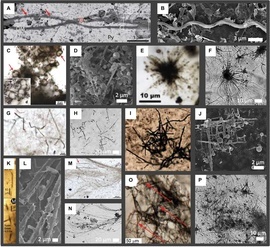Investigating the potential for pseudofossil formation in Earth's ancient sediments.
[sciencythoughts.blogspot.com]
The earliest evidence for life on Earth comes in two forms; chemical evidence, i.e. compounds believed to have been derived from the activities of living organisms and isotopic signals thought to be indicative of biological activity, and through the presence of structures believed to be microfossils in ancient sedimentary deposits. In both cases, identifying these with confidence requires considerable skill, as there remains a danger that abiotic processes might have achieved the same results. One of these dangers is the potential formation of pseudofossils (structures which resemble fossils but are of non-biological origin). The most ancient structures interpreted as being microfossils take two forms, microbial filamentous and spherical cells, but structures morphologically similar to both of these have been synthesised on the lab by non-biological means, raising the possibility that none of these ancient 'fossils' are actually of biological origin. The researchers were able to recreate these strucutures, also known as organic biomorphs, by oxidising sulphides in the presence of organic materials, under which circumstances they formed spontaneously. This has been shown to be possible under a wide range of conditions likely to have been present on the ancient Earth, and with a wide range of organic compounds serving as precursors.


Enjoy being online again!
Welcome to the community of good people who base their values on evidence and appreciate civil discourse - the social network you will enjoy.Create your free account
Recent Visitors 15
JoeB
UK
DenoPenno
MO, USA
waitingforgodo
Earth,
StarvingArtist
Tahlequah,OK Fayetteville,AR,
t1nick
Western,
Photos 292 More
Posted by JoeBKite-like structures in the western Sahara Desert.
Posted by TriphidAn Aussie Indigenous Message Stick.
Posted by TriphidIndigenous Australian Aboriginal Rock art dated somewhere between 20 and 30 thousand years old.
Posted by TriphidIndigenous Australian Aboriginal Rock art dated somewhere between 20 and 30 thousand years old.
Posted by TriphidIndigenous Australian Aboriginal Rock art dated somewhere between 20 and 30 thousand years old.
Posted by TriphidIndigenous Australian Aboriginal Rock art dated somewhere between 20 and 30 thousand years old.
Posted by JoeBDortoka vremiri: A new species of Dortokid Turtle from the Late Cretaceous of the Hațeg Basin, Romania.
Posted by JoeBThe Cabeço da Amoreira burial: An Early Modern Era West African buried in a Mesolithic shell midden in Portugal.
Posted by JoeBMusivavis amabilis: A new species of Enantiornithine Bird from the Early Cretaceous Jehol Biota of northeastern China.
Posted by JoeBTorosaurus in Canada.
Posted by JoeBStone tools from the Borselan Rock Shelter, in the Binalud Mountains of northeastern Iran.
Posted by JoeBDating the Lantian Biota.
Posted by JoeBBashanosaurus primitivus: A new species of Stegosaur from the Middle Jurassic of Chongqing Municipality, China.
Posted by JoeBDetermining the time of year when the Chicxulub Impactor fell.
Posted by JoeBSão Tomé and Príncipe: Possibly the last country on Earth never to have been visited by a working archaeologist.
Posted by JoeBMambawakale ruhuhu: A new species of Pseudosuchian Archosaur from the Middle Triassic Manda Beds of Tanzania.






